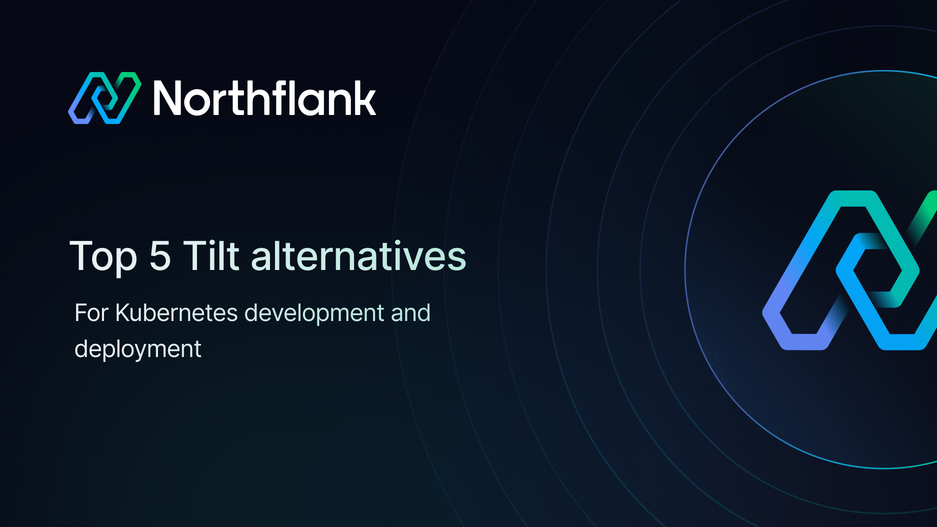

Top 5 Tilt alternatives for Kubernetes development and deployment in 2025
Tilt is an open-source toolkit for Kubernetes development that provides fast inner-loop iteration with live updates and a web UI for microservice development.
This guide covers alternatives to Tilt, comparing their approaches to Kubernetes development, production deployment capabilities, and use cases to help you find the right solution for your workflow.
-
Northflank (production deployment platform) – Complete platform that deploys and scales ANY containerized workload in production, from ML models to microservices.
Unlike Tilt's local development focus, Northflank provides production-grade infrastructure with CI/CD pipelines, release workflows, preview environments, and autoscaling. Deploy to Northflank's managed cloud or bring your own EKS, GKE, AKS clusters in minutes.
-
Skaffold – Google's command-line tool for continuous development on Kubernetes that automates the build, push, and deploy workflow.
-
DevSpace – CLI tool for developing and deploying applications on Kubernetes with file sync, port forwarding, and development containers.
-
Garden – Development automation tool with a graph-based approach to managing complex dependencies across microservices.
-
Okteto – Cloud development environments that sync local code changes to remote Kubernetes clusters.
Not all Kubernetes development tools solve the same problems. Before evaluating alternatives, clarify what you actually need.
-
Development stage focus:
Does the tool optimize local development iteration, production deployment, or both? Understand where your bottleneck actually is – inner loop development or post-commit workflows. Platforms like Northflank handle deployment, scaling, and operations after code is committed.
-
Cluster requirements:
Where will applications run during development? Consider whether your team needs local clusters, remote development environments, or production-grade infrastructure.
-
Configuration complexity:
How much Kubernetes knowledge does your team have? Some tools require an understanding of Kubernetes concepts and YAML manifests, while others, like Northflank, abstract complexity entirely.
-
Live update capabilities:
Can the tool update running containers without full rebuilds? This is critical for fast iteration. Check if it supports your stack, especially for compiled languages. Tools like Northflank support this.
-
CI/CD integration:
Does the tool provide building blocks for existing pipelines, or complete CI/CD automation? Ensure compatibility with your current systems. Some tools offer commands you integrate into Jenkins or GitHub Actions, while platforms like Northflank include built-in CI/CD with automated builds and deployments.
-
Multi-environment support:
Can you use the same tool and configuration for development, staging, and production? Using different tools for each environment creates inconsistencies. Platforms like Northflank provide unified workflows across all environments, while local-focused tools typically require separate production deployment solutions.
-
Production readiness:
Does the solution support production workloads with high availability, monitoring, autoscaling, and rollbacks? Development-only tools prioritize local iteration speed, while production platforms like Northflank deliver both fast deployments and production reliability at scale.
-
Cost structure:
What's the total cost of ownership? Open-source tools are free but require infrastructure management. Managed platforms charge for services but reduce operational overhead.
The right alternative depends on whether you're replacing local development capabilities, looking for production deployment infrastructure, or need a solution that handles both.
See a detailed comparison of each alternative below, including their key capabilities, use cases, and how they differ from Tilt.
Northflank takes a fundamentally different approach from Tilt. While Tilt optimizes local Kubernetes development and the inner loop, Northflank is a production deployment platform that runs your applications at scale.
How Northflank differs from Tilt
Tilt is a development tool for the inner loop. You use Tilt to iterate rapidly on your local machine or development cluster, seeing code changes reflected in seconds through live updates. Tilt helps you write code, build containers, and test locally before committing. It's designed to make local microservice development fast and painless.
Northflank handles everything that happens after you commit code. Deploy applications to production, scale workloads automatically, manage release pipelines, provision preview environments from pull requests, monitor services, handle secrets, and orchestrate databases – all from a unified platform.
While Tilt requires you to set up and manage your own Kubernetes cluster (local or remote), Northflank provides production-grade Kubernetes infrastructure out of the box. Deploy to Northflank's managed cloud or bring your own GKE, EKS, AKS, or bare-metal clusters through BYOC (Bring Your Own Cloud).
Key capabilities of Northflank
- Production deployment platform – Complete infrastructure for running applications at scale with CI/CD automation, release pipelines with promotion workflows, preview environments from pull requests, secrets management, monitoring and logging, autoscaling, health checks, rollbacks, and RBAC.
- Multi-cloud Kubernetes – Deploy to Northflank's managed cloud across global regions, or connect your own GKE, EKS, AKS, Civo, OKE, or bare-metal clusters. BYOC (Bring Your Own Cloud) provides a fully managed platform experience inside your VPC with complete control over data residency and security.
- Unified workload management – Run any containerized workload: microservices, APIs, databases (PostgreSQL, MySQL, MongoDB, Redis), background jobs, scheduled tasks, and GPU-accelerated applications. Deploy from Docker images or build automatically from Git repositories.
- GitOps CI/CD – Automatic builds and deployments triggered by commits, with support for GitHub, GitLab, and Bitbucket.
- Developer experience – No YAML required. Configure everything through an intuitive UI, powerful API, or CLI. Build and deploy in minutes, not days. Access real-time logs, metrics, and container state without kubectl.
Why teams use Northflank alongside or instead of Tilt
Teams using Tilt for local development often need robust production infrastructure for running applications at scale. Northflank addresses deployment, scaling, and operational management in a single platform.
You can use both Tilt and Northflank together:
- Use Tilt for rapid inner loop development on your local machine
- Push to Git when ready
- Let Northflank handle CI/CD, preview environments, staging, and production deployment automatically
This workflow gives you the best of both worlds: fast local iteration with Tilt, and production-ready deployment with Northflank.
Alternatively, teams often choose Northflank instead of Tilt when they want to:
- Remove the need for local Kubernetes cluster management entirely
- Deploy preview environments automatically from pull requests
- Run development, staging, and production on the same platform
- Focus on shipping features rather than managing development infrastructure
Companies like Weights & Biases scaled to serve millions of users using Northflank, running over 10,000 AI training jobs and half a million inference runs daily without managing Kubernetes directly. AI companies deploy models trained anywhere, serving inference endpoints with automatic scaling and GPU provisioning.
Try Northflank's free developer sandbox or book a demo to speak with an engineer. See pricing details.
Best for: Teams needing production deployment infrastructure, organizations wanting to avoid local Kubernetes management, companies requiring preview environments and release pipelines, and teams wanting unified infrastructure for development through production.
Skaffold is Google's open-source CLI tool for continuous development on Kubernetes, designed to handle the full workflow from code to deployment.
Key capabilities
- Pluggable build system with support for Dockerfile, Jib, Buildpacks, Bazel, and custom scripts
- Automated deployment to local or remote Kubernetes clusters using kubectl, Helm, or Kustomize
- File synchronization for fast updates without rebuilding containers
- Built-in debugging support for Java, Node.js, Python, and Go applications
- CI/CD integration for both inner and outer loop workflows
- Multi-environment configuration with profiles for dev, staging, and prod
Best for: Teams comfortable with CLI tools, organizations using Google Cloud, and developers wanting flexibility in build and deployment strategies.
DevSpace is an open-source CLI tool for developing and deploying applications on Kubernetes with file sync, port forwarding, and development containers.
Key capabilities
- Dev containers that mirror production environments while enabling hot reloading
- File synchronization between local machine and containers running in Kubernetes
- Port forwarding and log streaming for debugging
- Pipeline automation for build, deploy, and test workflows
- Namespace isolation for multi-tenancy and team development
- Hooks and custom commands for extending functionality
Best for: Teams wanting an open-source alternative with customization options, organizations needing development and production parity.
Garden takes a project-level approach to Kubernetes development, building a dependency graph of your entire stack.
Key capabilities
- Graph-based dependencies that understand relationships between services at build, deploy, and test phases
- Multi-environment testing with automated test execution in Kubernetes
- Service-level caching for faster builds and deployments
- Stack-wide operations that understand service dependencies
- Remote Kubernetes support for cloud-based development clusters
- Plugin system for extending capabilities
Best for: Teams managing complex microservice architectures with intricate dependencies, organizations needing advanced testing workflows.
Okteto provides cloud development environments that sync local code changes to remote Kubernetes clusters in real-time.
Key capabilities
- Remote development environments that reduce the need for local Kubernetes
- File synchronization between local IDE and remote containers
- SSH server support for direct container access
- Automatic environment cleanup for temporary development spaces
- Namespace per developer for complete isolation
- CLI and cloud platform for both open-source and managed options
Best for: Teams preferring remote development over local clusters, organizations wanting to reduce laptop resource requirements.
Selecting the right tool depends on what stage of the development lifecycle you're optimizing.
| Scenario | Tool Type | When to Use |
|---|---|---|
| Local development tools (Tilt, Skaffold, DevSpace) | Inner loop focused | Fast local iteration with control over your development environment, offline capability, and quick feedback before committing. |
| Production platforms (Northflank) | Post-commit workflows | Production-grade infrastructure with high availability, automated CI/CD and release workflows, preview environments from PRs, unified platform for all environments (dev/staging/prod), multi-cloud support, and runs any workload including apps, databases, jobs, and GPUs |
| Use both together | Optimal workflow | Local tool (Tilt, Skaffold) for rapid development iteration, production platform (Northflank) for everything after git push |
Many teams start with local development tools and later adopt production platforms as they scale. Some teams skip local Kubernetes entirely and use remote development environments or preview environments on production platforms.
Northflank bridges the gap between development and production by providing a complete platform that handles both preview environments for development and production workloads at scale. You get fast iteration through preview environments combined with production-grade infrastructure, taking out the complexity of managing multiple tools.
Start with a solution that matches your primary use case. Try Northflank's Developer free sandbox or schedule a demo with an Engineer to see how a unified deployment platform handles the full lifecycle from development to production.